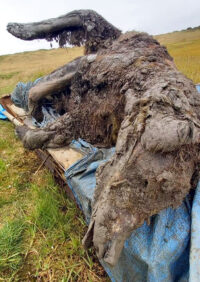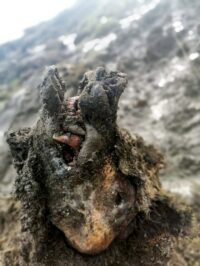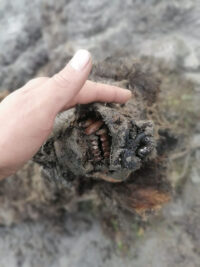 The body of an Ice Age cave bear has been discovered in exceptional condition on Bolshoy Lyakhovsky Island in Siberia. It was discovered by reindeer herders in the melting permafrost. They were just in time, because the exposed carcass would have decomposed rapidly after losing its frozen home. Instead, it is impeccably preserved, complete with all of its internal organs, soft tissues, fur, gums, teeth, even its nose. A frozen cub has been found before, and skeletal remains of adults, but this is the first intact adult cave bear ever discovered.
The body of an Ice Age cave bear has been discovered in exceptional condition on Bolshoy Lyakhovsky Island in Siberia. It was discovered by reindeer herders in the melting permafrost. They were just in time, because the exposed carcass would have decomposed rapidly after losing its frozen home. Instead, it is impeccably preserved, complete with all of its internal organs, soft tissues, fur, gums, teeth, even its nose. A frozen cub has been found before, and skeletal remains of adults, but this is the first intact adult cave bear ever discovered.
The remains have been recovered and will be studied by by scientists at the North-Eastern Federal University (NEFU) in Yakutsk, which is home to the Mammoth Museum Laboratory, the world’s premier institution dedicated to the study of mammoth and other Ice Age fauna.
The cave bear (Ursus spelaeus) is a prehistoric species or subspecies that lived in Eurasia in the Middle and Late Pleistocene period and became extinct about 15,000 years ago.
Preliminary analysis suggests the bear to be between 22,000 and 39,500 years old.
“It is necessary to carry out radiocarbon analysis to determine the precise age of the bear,” said senior researcher Maxim Cheprasov from the Mammoth Museum laboratory in Yakutsk. The finder transferred the right to research to the scientists of NEFU, he said. […]
A scientific programme for its comprehensive study will be prepared. We will have to study the carcass of a bear using all modern scientific research methods – molecular genetic, cellular, microbiological and others.
Researchers from around the globe will be invited to participate in the study of this unique survivor from the Ice Age.

